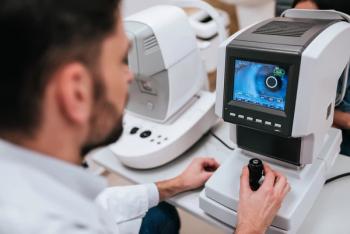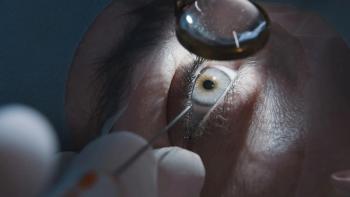Pediatric myopia is often dismissed as a simple problem of refractive error, but it is far more serious than blurry vision or frequent prescription changes. It’s a progressive disease that alters the structure of the eye, causing it to grow longer. That growth brings the increased risks of sight-threatening complications such as myopic macular degeneration and retinal detachments.1-6 Once seen as a benign childhood issue, myopia has now escalated into a global pandemic and is the leading cause of vision loss affecting millions of children.
Growing pandemic
One in 3 children worldwide has myopia, and the prevalence is rising so steadily that if it continues as predicted, there will be more than 740 million pediatric cases by 2050.1 An earlier study concluded nearly 5 billion people worldwide—about half the global population—will be myopic by midcentury.2 The severity of myopia is also rising at an alarming rate as children are developing the condition earlier.
The development of myopia was once thought to be largely dependent on genetics. Now it's become clear that a shift in how children spend the majority of their time, inside instead of outside, and often looking at screens, has triggered this disturbing trajectory. Children develop myopia younger, it progresses faster, and their long-term risks increase dramatically.3,4
When we think about our own practices, we begin to understand the magnitude. Half of our 11- to 13-year-olds have myopia, and by the time they get to be 17 to 19, that increases to 59%.5 Myopia is not a small problem in your practice or mine, it is huge. It is time to take a look at this in a new light.
More than a refractive condition
Although prescriptions measure the refractive error, myopia is often degenerative, and its biological impacts are what matter most. As the eye elongates, ocular tissues are strained or stretched, setting the stage for lifelong and irreversible vision complications. Even low levels of myopia, which represent roughly 60% of all cases, carry increased risks (see Table). Higher degrees of myopia dramatically elevate those risks.6-10
Table. Increasing Risk of Comorbidities With Increasing Myopia6
The increasing risks associated with higher levels of myopia are alarming, and yet that should not overshadow the need to address even low amounts to stop it from progressing.11 In their paper, "Every Diopter Matters," Mark Bullimore and Noel Brennan wrote, "reducing the incidence or prevalence of any disease by 40% is of huge public health significance. Slowing myopia by 1.00 D may do just that for myopic maculopathy—the most common and serious sight-threatening complication of myopia."
All too often, we clinicians overlook small refractive errors or low amounts of refractive change, as it does not impact our young patients' quality of life. In my experience as a referral center, I routinely will see clinicians start to talk about pediatric myopia when progression has been 0.75 D to 1.00 D a year for multiple years in a row. By the time I see them, their refractive correction is quite elevated, and more importantly, their axial elongation is well beyond the norm. Stretching has already occurred, elevating risks for maculopathy and other pathologies. The younger a patient is when they first become myopic, the longer their eyes will become. Like any other tissue-changing pathology, we can no longer overlook these risk factors. To combat myopia and its associated eye stretching, we must treat children early, tracking their changes as they age. The longer we can stave off myopia's development, the less likely it will progress to high levels.
Other health concerns associated with myopia
High myopia patients have decreases in quality of life similar to those of patients with keratoconus.12 Eye care providers are quick to recognize the difficulties faced by a keratoconic patient, yet we oftentimes do not attribute those same struggles to patients with high amounts of refractive error. A paper published in Ophthalmology found that vision impairment has a significant effect on depression and anxiety in children compared with those who are emmetropic.13
Children are resilient, yet we know patients who avoid sports or other activities because of poor vision. They may become isolated and less social, resorting to more time indoors, which unfortunately may lead to more screen time. This leads to more myopia and patients head down a path of withdrawal, resulting in more depression and anxiety. We are in a position to observe this in patients and families we see year after year. Consider the difference between patients who are higher myopes vs those in a similar age bracket with no refractive error or a small amount of ametropia.
We know that the parents of children with myopia also struggle with their mental health.14 I encourage eye care providers to collaborate with our mental health colleagues for advice and possible referral.
The need for comprehensive myopia management
Having the conversation
Talking to parents about pediatric myopia can be challenging due to the seriousness and complexity of the topic. Here are some conversational tips:
I might show parents what their child's vision would look like when they can't wear glasses (using trial lenses or a vision simulator). I tell parents that contact lenses or regular glasses won't slow the progression, instead it will just mask the blurring of their vision.
I explain that when myopia starts early, it causes the child’s eye to stretch and that your child's prescription will get higher as a result, and that decreases their quality of life considerably. I may say, "I'm concerned this is happening because your child’s eyes are stretching faster than normal." Using a growth chart to show where the child is, I will show them where the eye growth is right now versus where a typical child the same age would be. In other words, this 6-year-old has the eyes of an 18-year-old already—stretched out beyond what they should be.
"As an eye doctor I am concerned about the undue stress that this stretching puts on the eye over time, which we have seen will increases the risk of eye diseases later in life. Right now, at their age, this is not a concern yet, but the stretching that is occurring now is pointing towards it and I don't want this to happen, so we need to act now to slow this down." Then I ask, "Would you like to start slowing it down the stretching now or do you want to see how much more it has progressed when we see you in 3 months?
We don't say if it's progressed, we say how much more it has progressed, and it always will. I encourage practitioners to see patients back every 3 months particularly when patients are in that 5- to 8-year range, and they have myopia. This way we can demonstrate to the parent how much change has occurred.
We eye care providers can stop the development of later-stage myopia complications—both structural (axial elongation and retinal changes) and physiological (visual function and mental health effects)—by arresting its progression early. We must be willing to diagnose children and intervene. Remember, it's not the refraction we are concerned about; it's the damage being done to the eye when progressive myopia is left unchecked.
We must learn how to educate parents about the available tools and impress upon them the importance of early intervention. To do this, we demonstrate using lenses, or visual aids like charts and graphs based on the data, the changes a child's vision will undergo as their myopia progresses.
Current options for intervention
Although treatment for pediatric myopia in the United States is advancing, options remain limited. Those most commonly prescribed are discussed below.
- MiSight 1 day is the only FDA-approved intervention. The contact lens therapy is for myopia control in children ages 8 to 12. It has shown sustained reduction in myopic progression (0.67 D) and axial elongation (0.28 mm) over 3 years, with continued benefit through 6 years.15 While I have seen great success with this lens in practice, not all parents wish to have their young children wear contact lenses at school. They are an excellent option for some older children.
- Orthokeratology (ortho-k) uses gas-permeable contact lenses to temporarily reshape the cornea overnight and has demonstrated a 0.2- to 0.3-mm reduction in axial elongation over 2 years.16-20 This approach has shown synergy with low-dose atropine, creating an even greater myopia reduction.21,22 As with all contact lenses, proper education and management of the child's safety is paramount. Microbial keratitis incidence is low; nevertheless, infection risk factors should be discussed.23
- Low-dose atropine (0.01–0.05%, compounded) is widely prescribed off-label and is an extensively studied and effective pharmaceutical treatment. Large trials have demonstrated consistent reduction in both myopic progression and axial elongation.24 Several low-dose atropine products are approved internationally and have been shown to reduce myopic progression by 30% to 60% (depending on concentration and formulation).25 Unfortunately, compounded atropine in the United States lacks consistency in drug concentration, pH, and preservative content. Variability in compounded products has led to concerns around efficacy, sterility, and patient adherence. 26-28 Like many myopia management practices, we prescribe atropine to a large percentage of our myopia management patients. When the drops are not working as we anticipated, we are left to wonder about variation among pharmacies.
Landmark therapy on the horizon: Proprietary, low-dose atropine
If approved by the FDA, SYD-101 (Sydnexis) would become the first standardized pharmaceutical treatment for pediatric myopia, ushering in a new era of myopia management. The proprietary, preserved, low-dose atropine formulation with a neutral pH has been evaluated to slow the progression of pediatric myopia and the risk of associated comorbidities in children 3 to 14 years old in the company's pivotal STAR phase 3 clinical trial. The 852-participant study is the largest study of its kind ever conducted for the treatment of pediatric myopia. The FDA has set a PDUFA date for SYD-101 of October 23, 2025.
Recommending the best treatment option
When it comes time to prescribe an intervention, we inform parents of the best option for their child and why. A pharmaceutical approach like SYD-101 could fit in at any level of myopia, but particularly with younger children who are likely to progress the fastest and may not be at a point where they can wear the FDA-approved contact lens options. It may also be promising as an additive therapy, as we know that ortho-k plus atropine boosts the progression-slowing of each treatment alone.
Extensive data and experience with low-concentration atropine have shown its safety, efficacy, and reduced adverse effects. With all of our myopia management treatments, regular follow-up is important. We ask parents if they have noted any changes to mood or behavior, and we ask patients about any light sensitivity or alterations in vision.
Conclusion
What today's data reveal is clear: refractive error is the tip of the myopia iceberg. The real concern is under the surface, where earlier onset and accelerated progression stretch the eye, increasing the risk of sight-threatening disease. Early detection and intervention are essential.
With the promise of a new atropine formulation and a concerted effort to intervene sooner in pediatric myopia, eye care providers can stem the tide of ocular complications later in life and protect children's current and future mental health.
References
1. Liang J, Pu Y, Chen J, et al. Global prevalence, trend and projection of myopia in children and adolescents from 1990 to 2050: a comprehensive systematic review and meta-analysis. Br J Ophthalmol. 2025;109:362-371.
2. Holden BA, Fricke TR, Wilson DA, Jong M, Naidoo KS, Sankaridurg P, Wong TY, Naduvilath TJ, Resnikoff S. Global prevalence of myopia and high myopia and temporal trends from 2000 through 2050. Ophthalmology. 2016;123(5):1036-42. doi:10.1016/j.ophtha.2016.01.006
3. Hu Y, Ding X, Guo X, Chen Y, Zhang J, He M. Association of Age at Myopia Onset With Risk of High Myopia in Adulthood in a 12-Year Follow-up of a Chinese Cohort. JAMA Ophthalmol. 2020;138(11):1129-1134. doi:10.1001/jamaophthalmol.2020.3451.
4. Wang J, Li Y, Musch DC, Wei N, Qi X, Ding G, Li X, Li J, Song L, Zhang Y, Ning Y, Zeng X, Hua N, Li S, Qian X. Progression of myopia in school-aged children after COVID-19 home confinement. JAMA Ophthalmol. 2021;139(3):293-300. doi:10.1001/jamaophthalmol.2020.6239
5. Theophanous C, Modjtahedi BS, Batech M, Marlin DS, Luong TQ, Fong DS. Myopia prevalence and risk factors in children. Clin Ophthalmol. 2018;12:1581-1587. https://doi.org/10.2147/OPTH.S164641
6. Leveziel N, Marillet S, Dufour Q, Lichtwitz O, Bentaleb Y, Pelen F, Ingrand P, Bourne R. Prevalence of macular complications related to myopia - Results of a multicenter evaluation of myopic patients in eye clinics in France. Acta Ophthalmol. 2020;98(2):e245-e251. doi:10.1111/aos.14246
7. Flitcroft DI. The complex interactions of retinal, optical and environmental factors in myopia aetiology. Prog Retin Eye Res. 2012;31:622-60.
8. Vongphanit J, Mitchell P, Wang JJ. Prevalence and progression of myopic retinopathy in an older population. Ophthalmology. 2002;109(4):704-711.
9. Ogawa A, Tanaka M. The relationship between refractive errors and retinal detachment–analysis of 1,166 retinal detachment cases. Jpn J Ophthalmol. 1988;32:310-5.
10. Mitchell P, Hourihan F, Sandbach J, Wang JJ. The Relationship between glaucoma and myopia: The Blue Mountains Eye Study. Ophthalmology. 1999;106:2010-5.
11. Bullimore MA, Brennan NA. Myopia control: why each diopter matters. Optom Vis Sci. 2019;96(6):463-465. doi:10.1097/OPX.0000000000001367
12. Rose K, Harper R, Tromans C, Waterman C, Goldberg D, Haggerty C, Tullo A. Quality of life in myopia. Br J Ophthalmol. 2000 Sep;84(9):1031-4. doi:10.1136/bjo.84.9.1031
13. Li D, Chan VF, Virgili G, Piyasena P, Negash H, Whitestone N, O'Connor S, Xiao B, Clarke M, Cherwek DH, Singh MK, She X, Wang H, Boswell M, Prakalapakorn SG, Patnaik JL, Congdon N. Impact of vision impairment and ocular morbidity and their treatment on depression and anxiety in children: a systematic review. Ophthalmology. 2022;129(10):1152-1170. doi:10.1016/j.ophtha.2022.05.020
14. Guo LY, Sun H, Hu M, Jiang YH, Luo ZH. Mental health status of parents of young patients with high myopia. J Int Med Res. 2020;48(1):300060519873474. doi:10.1177/0300060519873474
15. Chamberlain P, Peixoto-de-Matos SC, Logan NS, et al. A 3-year randomized clinical trial of MiSight lenses for myopia control. Optom Vis Sci. 2019;96(8):556–567.
16. Chamberlain P, Bradley A, Arumugam B, Ngo C, Logan NS. Long-term effect of dual-focus contact lenses on myopia progression in children: A 6-year multicenter clinical trial. Optom Vis Sci. 2022;99(3), 204–212.
17. Jakobsen TM, Møller F. Control of myopia using orthokeratology lenses in Scandinavian children aged 6 to 12 years. Eighteen-month data from the Danish Randomized Study: Clinical study Of Near-sightedness; TReatment with Orthokeratology Lenses (CONTROL study). Acta Ophthalmol. 2022 Mar;100(2):175-182. doi:10.1111/aos.14911
18. Sun Y, Xu F, Zhang T, Liu M, Wang D, Chen Y, Liu Q. Orthokeratology to control myopia progression: a meta-analysis. PLoS One. 2015 Apr 9;10(4).
19. Cho P, Cheung S-W. Retardation of myopia in Orthokeratology (ROMIO) study: a 2-year randomized clinical trial. Invest Ophthalmol Vis Sci. 2012;53:7077– 7085.
20. Bullimore MA, Johnson LA. Overnight orthokeratology. Cont Lens Anterior Eye. 2020;43:322–332.
21. Tan Q, Ng ALK, Cheng GPS, Woo VC. Combined 0.01% atropine with orthokeratology in childhood myopia control (AOK) study: A 2-year randomized clinical trial. Cont Lens Anterior Eye. 2023;46(1):101723.
22. Yu S, Du L, Ji N, et al. Combination of orthokeratology lens with 0.01% atropine in slowing axial elongation in children with myopia: a randomized double-blinded clinical trial. BMC Ophthalmol. 2022;22:438.
23. Kam KW, Yung W, Li GKH, Chen LJ, Young AL. Infectious keratitis and orthokeratology lens use: a systematic review. Infection. 2017;45(6):727-735.
24. Chia A, Chua WH, Cheung YB, Wong WL, Lingham A, Fong A, Tan D. Atropine for the treatment of childhood myopia: safety and efficacy of 0.5%, 0.1, and 0.01% doses (Atropine for the Treatment of Myopia 2). Ophthalmology. 2012;119(2):347-54. doi:10.1016/j.ophtha.2011.07.031
25. Yam JC, Jiang Y, Tang SM, et al. Low-concentration atropine for myopia progression (LAMP) study: A randomized, double-blinded, placebo-controlled trial. Ophthalmology. 2019;126(1):113–124.
26. Iribarren R, Cunha C, Kaymak H, Grzybowski A. Preservatives and pH in low-dose atropine formulations for clinical trials. Acta Ophthalmol. 2023;00:1–3.
27. Mughal S, Sakina SK. Artificial tears: Promising treatment or silent threat to public health? Health Sci Rep. 2023 Aug 24;6(8):e1508. doi:10.1002/hsr2.1508
28. Richdale K, Wagner H, Zadnik K. What’s in the bottle? Variability in compounded atropine formulations for myopia. JAMA Ophthalmol. 2023;141(1):22–30.






